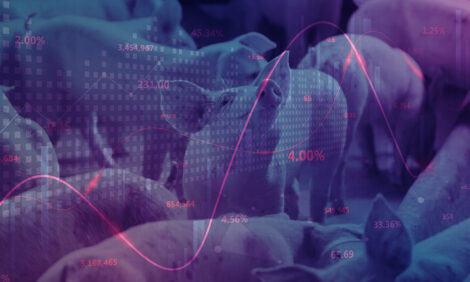



Alberta Hog Market Commentary and Outlook - Fall 2005
By Kevin Grier, Senior Market Analyst, George Morris Centre, in Guelph and Calgary. Published by Alberta Pork. This is the latest Alberta Hog Market Commentary and Outlook which discusses the USDA's Hogs and Pigs report and Bird Flu's effect on pork prices.U.S. Market Outlook
The September United States
Department of Agriculture (USDA) Hogs
and Pigs Report contained no surprises,
which was very surprising. Pre-report
expectations were for very modest
growth, and that, in fact is what the actual
report indicated. The U.S. inventory of all
hogs and pigs on September 1, 2005 was 61.5 million head. This
was up slightly from September 1, 2004, and up one percent from
June 1, 2005. Breeding inventory, at 5.97 million head, was up less
than one percent from last year, but down less than one percent
from last quarter.
That modest expansion is, of course, the surprising part. Given
the fact that as of September, the U.S. hog production sector had
enjoyed nearly 20 months of profitability, some were naturally
expecting a little more of an aggressive expansion.
With that noted, however, the important question is what it
means for slaughter and production in the coming quarters. The
bottom line is that it appears that 2006 U.S. slaughter is going to be
about one percent greater than 2005. That makes 2006 another
record year for U.S. slaughter and production, and it continues a
string of six straight years of increased slaughter. See Figure 1.

So if the supply situation for 2006 is now at least relatively clear,
the question turns to the other part of the pricing equation –
demand. In my estimation, U.S. demand for pork has been strong,
but not exceptional. Figure 2 shows one way to illustrate pork
demand. The graph takes the U.S. consumer price index for pork
and multiplies that by the USDA’s estimate of pork consumption
and then indexes the data so that the first quarter of 2002 is the
base = 1.
Figure 2 shows that since 2001, U.S. pork demand has been
gradually increasing. This gradual increase in pork demand is
part of the reason why the industry has been able to support
ever-increasing pork supplies.
The other component of demand, of course, is export
demand. In that regard, Figure 3 shows the performance of U.S.
pork exports over the past three years.

On a dollar basis, U.S. pork exports year-to-date through
August were up 32 percent while on a volume basis, the exports
increased by 29 percent. High-profile international drivers, such
as the refusal of the Japanese to take North American beef,
Avian Influenza in southeast Asia and Foot-and-Mouth Disease
(FMD) in South America, have all had a positive impact on North
American pork exports.
Clearly, both export and North
American demand have been the
reasons why the industry is able to
support annual increases in pork
production without material
decreases in prices. I noted in my
last quarterly report to Alberta
Pork members that demand is
keeping prices much higher than
would have been expected in the
past, given the volume of
production.

I noted that price
levels in 2004 were more than 40
percent higher than would have
been expected with similar supply
levels during the 2000 through 2003
period. During the first three
quarters of 2005, prices were 35 percent, 25 percent and 19
percent higher than would have been the case in those quarters
from 2000-2003. As such, it is easy to understand just how
important demand is for price support. Conversely, any negative
changes in demand will be the reason why prices come under
pressure. In that regard, John Lawrence, professor at Iowa
State University offers the following comments regarding
demand risks1:
“Domestic demand for beef and pork has been strong and
growing in recent years. However, increased energy costs are
expected to impact consumer spending, particularly as the
winter progresses and the heating bills arrive. Another risk to
beef and pork prices is Avian Influenza also called the “bird flu.”
People cannot get bird flu by eating poultry products, but if
customers, particularly export
customers, of U.S. poultry switch
away from poultry it will back
poultry up into the U.S. market
making it cheaper. We saw a
sample of this in 2002 when
Russia blocked U.S. broiler
imports and chicken prices in
U.S. grocery stores dropped
dramatically, pressuring beef
and pork prices.”
1:http://www.econ.iastate.edu/outreach/agricult
ure/periodicals/ifo/IFO_2005/ifo103105.pdf

Prairie Initiatives
The past quarter has seen the continuation of relatively good
margins and good news for hog producers. From the beginning of
2003 through the third quarter of 2005, Alberta hog producers
have been in the black for nine out of the thirteen quarters.
Furthermore, while energy costs are a big factor this winter, the
fact is that the biggest cost component - feed - is going to be
abundant and comparatively inexpensive for Alberta producers.
Figure 4 shows estimated gross and net margins. From 2002
onward, the data was supplied by Bert Dening of Alberta
Agriculture’s Barrhead office.
Meanwhile, during the last quarter, things got interesting on
the hog-packing front. In early October, Winnipeg Free Press ran
a story regarding the possibility that Olymel will be building a new
hog kill plant in Winnipeg. As of early November, the company has
neither confirmed nor denied anything about the plant. While the
article was short on hard facts, The Free Press offered readers an
assurance from a University of Manitoba professor that Olymel is
“not a fly-by-night company.” Other than the fact that Olymel is
not a fly-by-night company, nothing else is certain. That, of
course, did not stop further speculation in the article that the $130
million plant will be killing, sometime, around two million head per
year. The article also quoted the requisite hand-wringer, who is
concerned about the plant that may or may not be built. Fred Tait,
a member of Hogwatch Manitoba, said the smell of hog
excrement could be a concern for people living close by. He
added that another processing
plant could encourage more large
hog barns to be built. His group is
concerned about the impact such
operations have on the
environment.
Actually, if The Free Press
really wanted to get a quote from
someone who is concerned about
the plant, they should have called
Maple Leaf. If this plant is going
to be a reality, it is going to
tighten up the supply-demand
balance on the prairies. This year,
an average of 26,000 slaughter
barrows and gilts left the eastern
prairies each week for slaughter
in the U.S. Corn Belt. If the plant is
going to be a two million per week plant as suggested in the
article that means it would be killing about 40,000 per week.
With
that said, that two million estimate was likely based on a 20,000
head single shift plant. Assuming it takes the usual length of time
to get a double shift going, meaning about 100 years, then the
plant in theory could reasonably be accommodated. That does not
even consider that some of the 75,000 western feeders would
likely stay for finishing if there was a new plant.
Nevertheless, there will still be plenty of those slaughter
barrows and gilts heading south, even with a new plant.
Southeast Manitoba is Morrell country. Southeast Manitoba
producers appreciate the pricing offered out of Sioux Falls. The
bottom line is that the new plant will almost definitely result in
tighter basis and price spreads on the prairies. If Maple Leaf
Brandon is finding it tough now with its current low hog costs, then
it is going to be much worse with a tighter basis. At the very least,
if there is going to be a new plant, it is going to make things very
interesting for Maple Leaf.
Then again, it is best not to get too excited about the prospect of
a new plant. Over the last few years, it seems that packers derive
some pleasure talking to various governments and reporters about
new plants, thereby generating a pile of useless press clippings.
The contrast with the U.S. is dramatic. If Smithfield, Hormel or
Triumph say they’re going to build a plant or expand capacity by a
certain amount, it will happen, and will usually be done within a
month or so of what they originally said (barring perhaps a careless
former welder or two). Or as is currently the case, if they say they
are going to close a plant and streamline operations, it will all
happen within a day or two of what they originally said.
Further to that point, a friend of mine in the U.S. sent me a note
recently saying that “the first day a Canadian plant goes a full
second shift, let me know and I’ll send you a bottle of good
whiskey, providing we’re both still alive.”
Price Forecasts
Once again, any forecast of price becomes an exercise in trying to anticipate what could go wrong on both the domestic and export
demand side of the equation. The following table shows my price forecasts for the U.S. National Base Lean carcass basis and the Alberta
Index 100 price level. The Alberta forecasts are based on an 85-cent dollar during the first half of 2006 and an 86-cent dollar in the second
half. The Alberta forecasts are also based on current formulas being offered in the province.

Source: Alberta Pork Market Review - Fall 2005








